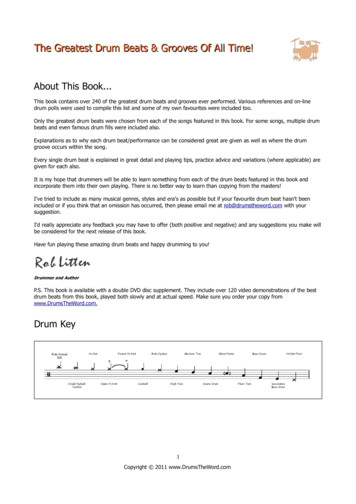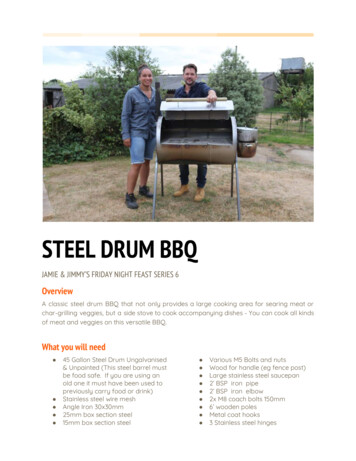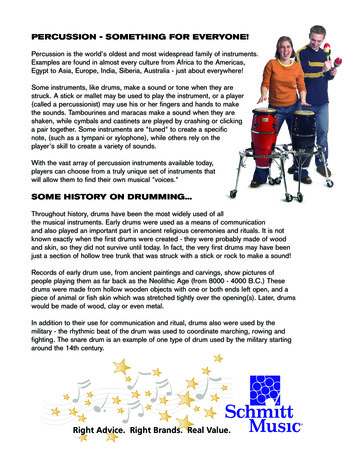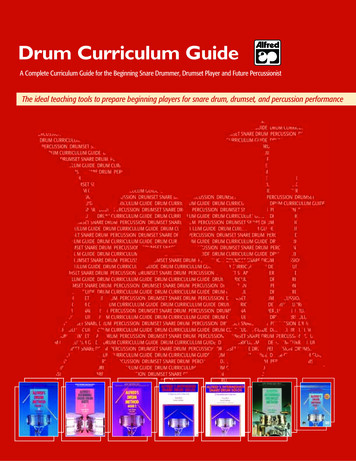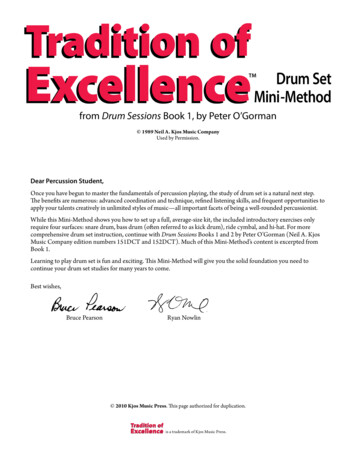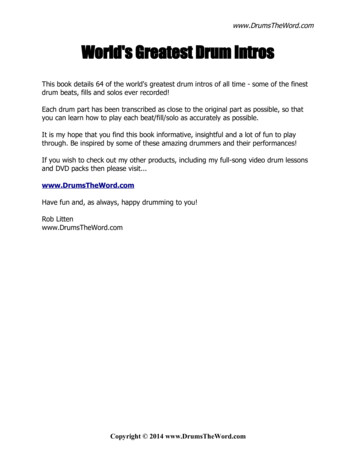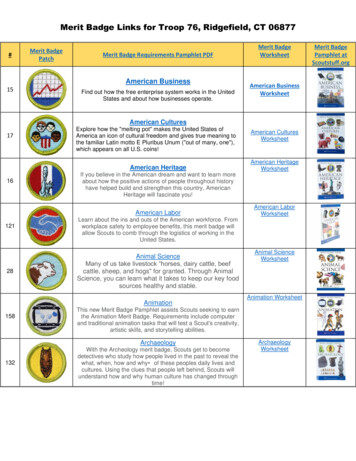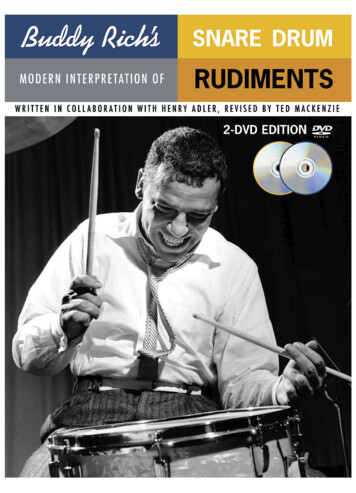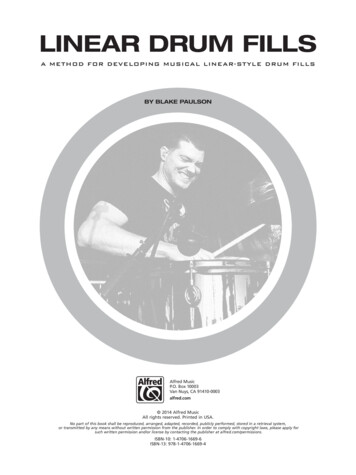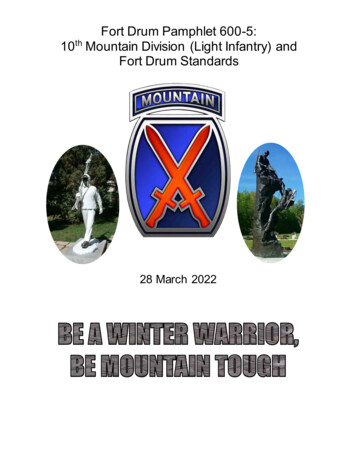
Transcription
Fort Drum Pamphlet 600-5:10th Mountain Division (Light Infantry) andFort Drum Standards28 March 2022
Welcome to the Mountain, Enjoy the ClimbThis pamphlet describes general rules and policies while serving in the 10th Mountain Division andFort Drum. The intent is to set standards, maintain discipline, and build esprit de corps for all of ourSoldiers and units. We expect all Soldiers to know and follow these standards.We share four enduring priorities that enable us to put people first and construct winning teams.When in doubt, look to these priorities to shape how you train, and how you conduct yourself. You will findthat focusing on “what we do” and “why we do it” will guide you on the path to success. We move forwardthrough teamwork, aligning with the following priorities:1. People are what make up the Mountain Team. The decisive advantage we maintain against ouradversaries is our people. Soldiers, masters of their craft, led by well-engaged leaders, willdefeat any enemy. Our team also includes our DA Civilian professionals who provideimmeasurable experience and expertise and the Families who are ‘on belay’ while we climb. OurMountain Tough Team can conquer every summit but we must continually place energy andresources to ensure our teammates truly believe that this division places People First.2. Readiness. The 10th Mountain Division is ready right now. Our ability to provide a ready force ispart of our tough culture. We do not cut corners in readiness. Leaders balance activities andpriorities to ensure their units maintain holistic readiness and provide the requisite time to addresseach of the readiness drivers – Personnel, Maintenance, Supply and Training.3. Leader & Civilian Development. Our success in every area begins with Soldier Leaderdevelopment. Certifying Leaders is essential for effectiveness in every domain. There are sixleadership development domains; we will develop leaders to solve problems, deal withuncertainty, take care of people, steward the Army profession, and master doctrine and tactics.4. Quality of Life. Is a broad concept covering areas ranging from living spaces to qualityprograms and services. Mountain Soldiers enjoy a quality of life that is comparable to no otherexperience in the Army. We have an abundance of community resources on both Fort Drum andFort Polk. To retain and attract talented people, we will communicate better and more consistentlyto ensure our Families and Soldiers understand what the installations and communities have tooffer.As the most deployed Division in the Army, Mountain Soldiers have a legacy and history to remindthem of the price necessary to maintain that status. Just as MG George P. Hays told the MountainSoldiers before the assault of Riva Ridge, Stay in contact with the Soldier in front of you and nomatter what – keep moving. We will be at the top! We will keep climbing. When our Nation calls, itcalls the military. When the military calls, it calls the Army. When our Army calls, it calls the 10thMountain Division. WE will ensure that this remains true. Climb to Glory!MARIO O. TERENASCommand Sergeant Major, USADivision Command Sergeant MajorMILFORD H. BEAGLE JR.Major General, USADivision Commander10TH MOUNTAIN DIVISION (LI) & FORT DRUM PAMPHLET 600-5 28 MARCH 20222
Table of Contents1. Purpose, Applicability, Responsibilities, Open Door Policy2. Who We AreA. 10th Mountain Division (Light Infantry) HistoryB. Meaning of the 10th Mountain Division PatchC. 10th Mountain Division (Light Infantry) MottoD. 10th Mountain Division (Light Infantry) Song3. UniformsA. Class C UniformB. Combat Uniform (CU)C. Tactical UniformD. Army Physical Fitness Uniform (APFU)E. Cold Weather Uniform4. Soldier Conduct & Military CourtesyA. Conduct during Reveille & RetreatB. GreetingsC. Off Duty Appearance & ConductD. Off Limits AreasE. NoiseF. TrafficG. DrugsH. Alcohol UsageI. Firearms5. Health & FitnessA. Holistic Health & FitnessB. TimesC. CadenceD. On Post PT RoutesE. Off Post PTF. Unbreakable Warrior6. Single Soldier Housing PolicyA. Daytime VisitationB. Overnight VisitationC. Quiet HoursD. Alcohol7. Command Housing Visitation PolicyA. Command VisitsB. Content8. Assistance OrganizationsA. Army Community ServiceB. Inspector GeneralC. Legal AssistanceD. Fort Drum Claims OfficeE. American Red CrossF. ChaplainG. Education CenterH. Behavioral Health ServicesI. Interactive Customer Evaluation (ICE)10TH MOUNTAIN DIVISION (LI) & FORT DRUM PAMPHLET 600-5 28 MARCH 20223
AppendixesA1.A2.B1.B2.B3.C1.D1.E1.E2.F1.Tactical Uniform – Helmets, Fighting Load Carrier, Improved Outer Tactical Vest, RucksackAuthorized Protective Eyewear ListingWind Chill Chart & Uniform GuideExtended Cold Weather Clothing System (ECWCS) GuideGEN III ECWCS Quick ReferenceFort Drum PT / Running Route MapFort Drum Unit Areas of ResponsibilityFort Drum Key Agency Contact NumbersFort Polk Key Agency Contact NumbersThe National Anthem and The Army Song10TH MOUNTAIN DIVISION (LI) & FORT DRUM PAMPHLET 600-5 28 MARCH 20224
1. Purpose. To educate and inform all Uniformed Service Members of the 10th Mountain Division (LightInfantry) and other units assigned to Fort Drum regarding specific Division and Installation policies.A. Applicability. This pamphlet applies to all United State Service Members assigned or attachedto the 10th Mountain Division (Light Infantry) or Fort Drum. 10th Mountain Division Soldiers whoreside on other installations will comply with host installation standards and policies.B. Responsibilities. Commanders and leaders are held responsible to ensure Soldiers present aneat appearance and conduct themselves professionally at all times, on and off duty. All Soldierswill live by the Soldier’s Creed, the Warrior Ethos, the Army Values, take pride in theirappearance, and conduct themselves properly at all times.C. Open Door Policy. If you have a problem your first-line supervisor cannot solve, go see the nexthigher leader or commander. Every commander from the Commanding General (CG) down toCompany/Battery/Troop/Detachment commanders within the Division have an open door policy.Commanders are available to the Soldiers at all times. All Soldiers are free to use the open doorpolicy at any level after first notifying their chain of command of their intent to do so. Soldiers cancall the CG’s Hotline (315-772-6666). The CG’s hotline is for Soldiers, Family Members, orCivilians who feel that they have exhausted all other options and resources to solve the problemor issue. At Fort Drum and Fort Polk, the Commanding Generals ask that all enlisted open doorissues be directed to their Command Sergeant Major first.2. Who We Are.A. 10th Mountain Division (Light Infantry) History. The 10th Light Division (Alpine) wasconstituted on 10 July 1943, and activated on July 15, at Camp Hale, Colorado. After extensivewinter and mountain warfare training, the Division moved to Camp Swift, Texas, for additionalcombat training. The 10th Light Division was re-designated the 10th Mountain Division on 6November 1944 and deployed to the Italian theater soon thereafter. By January 1945, the divisionwas executing combat operations in northern Italy. During these operations, the 10th MountainDivision seized German positions within the Apennine Mountains, breaking through the Germanmountain defenses into the Po River Valley and reaching the northern end of Lake Garda by thewar’s end. During nearly five months of intense ground combat in Italy, the division was opposedby 100,000 German troops, yet effectively destroyed five German divisions, unhinging theGerman defense in Italy and drawing German forces away from other theaters. The divisionsustained nearly 5,000 casualties during World War II, with 1000 Soldiers killed in action.Following the German surrender, the 10th Mountain Division deployed to the Yugoslavian/Italianborder near Trieste, in a peacekeeping role. After redeploying, the division was inactivated on 30November 1945, at Camp Carson, Colorado. The 10th Infantry Division was reactivated as atraining division on 1 July 1948, at Fort Riley, Kansas. In January 1954, the Department of theArmy announced the 10th Infantry Division would become a combat infantry division scheduled torotate to Europe to deter the Soviet Union and the Warsaw Pact. Stretched in an arc fromFrankfurt to Nuremburg, the 10th Infantry Division occupied a strategic position in the center ofNATO defenses until replaced in 1958 by the 3rd Infantry Division. The division was inactivatedat Fort Benning, Georgia, on June 14, 1958.The 10th Mountain Division (Light Infantry) was reactivated at Fort Drum, New York, on February13, 1985, as one of the U.S. Army’s new "light infantry” divisions. It was designed to meet a widerange of worldwide missions, adding a new dimension to the strategic mobility of the ArmedForces. The division's rapid mobility was envisioned to enable the arrival of troops in a crisis areabefore conflict began and demonstrated U.S. resolve and capability. The 10th Mountain Division10TH MOUNTAIN DIVISION (LI) & FORT DRUM PAMPHLET 600-5 28 MARCH 20225
(Light Infantry) was designed to reassure friends and allies while deterring adversaries. Since itsreactivation, the 10th Mountain Division has been the U.S. Army’s most deployed division, bothbefore and throughout the Global War on Terrorism.B. Meaning of the 10th Mountain Division Shoulder Sleeve Insignia. The 10th Mountain Divisionpatch consists of a white bordered powder keg. The powder keg is in blue, with two red bayonetscrossed to form the Roman numeral “X” or ten superimposed on it. The bayonets represent theInfantry and the numerical designation of the Division. The word “MOUNTAIN” is in white on ablue tab affixed directly above the patch.C. The Division Motto “CLIMB TO GLORY”. The motto links the Division’s proud legacy fromWorld War II to the Soldiers who currently serve, at both Fort Drum and Fort Polk. Since itsreactivation, Soldiers of the 10th Mountain Division have answered our nation’s call in places likeSomalia, Haiti, Bosnia, Kosovo, Afghanistan, Iraq and many places in between.As noted during a 2010 speech, former Secretary of the Army John McHugh noted, “Soldiersfrom the 10th Mountain Division have represented the proud tradition of selfless service anddedication to excellence that is the hallmark of our Army. They make the seemingly impossible,not just possible, but almost simple.”D. The 10th Mountain Division Song “Climb to Glory”.We’re the 10th Mountain InfantryWith a glorious historyOn our own two feet, all our foes we’ll defeatLight Fighters marching on to victoryWe go where others dare not goIn the heat or cold of snowWe are proud to be in the Army of the FreeClimb to Glory, Mountain InfantryClimb to Glory, the Light Infantry10TH MOUNTAIN DIVISION (LI) & FORT DRUM PAMPHLET 600-5 28 MARCH 20226
3. Uniforms.A. Class C Uniform. The Class C uniform consists of combat, utility, field, garrison culinary,physical fitness and other organizational uniforms. These uniforms are designed to fit loosely andalternations to make them form fitting are not authorized. These uniforms will be clean,serviceable, and worn in accordance with AR 670-1 and DA PAM 670-1 along with any publishedALARACT, MILPER or other authorization unless specified below. These uniforms may not beworn in establishments that primarily sell alcohol and they are not considered appropriate for anysocial or official functions off the installation.B. Combat Uniform (CU).1) Definition. The daily work, utility and field uniform that encompasses both the Army CombatUniform (ACU) and the Improved Hot Weather Combat Uniform (IHWCU).2) When Worn. May be worn off post during duty hours at the discretion of the Soldier.Outside of duty hours, the CU is authorized for wear during short stops (10-15 minutes) topick up essentials. May be worn when consuming alcohol on post at unit functions /gatherings with prior approval from the Battalion / Squadron Commander.3) Accessories.a) Headgear. Soldiers will wear appropriate headgear when outdoors except when itinterferes with safety. The Patrol Cap is the primary day-to-day headgear. The Beret will be worn as the primary headgear for all ceremonies. The Sun Hat or “Boonie Cap” will only be worn for training events & deployments; it isnot authorized for wear outside of the training area. The Micro-fleece cap (Black or Tan) is authorized for wear from 01 October through01 May, when either directed by the chain of command or when the temperature(ambient or wind chill) reaches 32º F and below. The 10th Mountain Division embroidered micro-fleece cap is available for Soldiers topurchase to wear in lieu of the plain micro-fleece cap. If purchased, this cap will beworn with the embroidered 10th Mountain Division Patches of each ear.b) Cavalry Stetsons & Spurs. Stetsons and spurs are authorized for wear at Cavalryformations and functions when authorized by the Squadron Commander. They aregenerally NOT authorized for wear at Brigade or higher-level formations and functionsunless specifically requested and approved by the appropriate level Command SergeantMajor. Stetsons and spurs will be serviceable, clean and worn in a manner consistentwith the U.S. Cavalry traditions.c) Reflective Safety Belt. Leaders at every level are charged with the safety of theirSoldiers. As such, Company Commanders and above will evaluate situations anddetermine need for wear of reflective belts in order to mitigate risk. When worn with theCU the reflective belt will be worn right shoulder to the left hip.d) NCO Academy & Light Fighters School Instructor Shirts and Hats. Instructor shirtsand hats are authorized for wear by the NCO Academy and Light Fighter Schoolinstructors within the NCO Academy and Light Fighter School Areas only. They will notbe worn outside of those areas or while conducting non-instructor activities suchas going to PX, Commissary, etc.e) Baseball Caps. Units authorized to wear baseball style caps may only wear them intheir unit area. They will NOT be worn outside of the unit area for any reason.f) Full Color Shoulder Sleeve Insignia. IAW ALARACT 056/2021, Brigade Commandersmay authorize the wear of full-color Should Sleeve Insignia (SSI) on the ACU andIHWCU for special occasion such as, but not limited to, commemoration ceremonies or10TH MOUNTAIN DIVISION (LI) & FORT DRUM PAMPHLET 600-5 28 MARCH 20227
changes of command / responsibility. The full color SSI will NOT be worn outside of thearea where the ceremony or special event is being conducted.g) Sunglasses. Conservative prescription and nonprescription sunglasses are authorizedfor wear when in a garrison environment, except while indoors. Soldiers who arerequired by medical authority to wear sunglasses for medical reasons, other thanrefractive error, may wear them, except when health or safety considerations apply.Commanders may authorize sunglasses in formations or field environments, asapplicable.C. Tactical Uniform.1) Definition. Items worn with the combat uniform in tactical / training environments. Picturesaddress the proper setup of the tactical uniform are in Appendix A.2) When Worn. The Tactical Uniform will be worn anytime a Soldier enters the training area, oras otherwise directed by their chain of command.3) Accessories.a) Helmets. The helmets listed below are the only helmets authorized for wear by 10 thMountain Division Soldiers. Advanced / Enhanced Combat Helmet (ACH/ECH) will be worn complete withcamouflage cover, pad suspension system, retention system (chinstrap) fastened atall times, camouflage band and NVG mount (if issued). Camouflage band will be tieddown with 550 cord and have the Soldier’s name visible when worn. Name will eitherbe centered on the ACH/ECH (without NVG mount) or over the wearer’s right eye(with NVG mount). Integrated Head Protection System will be worn complete with camouflage cover,suspension system, retention system (chinstrap) fastened at all times, and NVGmount. Soldier’s nametape will be affixed to the rear Velcro panel. On the sideVelcro panels, Soldiers will affix a Mountain Tab at a minimum; Soldiers who haveearned other tabs (Ranger, Sapper, etc.) are encouraged to affix those as well. Additionally, Soldiers assigned to units that have distinctive patches can wear thosepatches in lieu of the Mountain / Ranger / Sapper tabs on one of the side Velcropanels. Battalions will develop an SOP to ensure uniformity within their formations.b) Ballistic Eyewear. From the Authorized Protective Eyewear List (APEL) located s/APEL-poster.pdf. Also shown inAppendix A.c) Gloves. Either issued or commercially purchased gloves that are flame resistant;fingerless gloves are not authorized.d) Body Armor. Many events do not require ballistic protection, but live-fire training,tactical training scenarios with an opposing force, and deployments do. When bodyarmor is required, Soldiers are authorized to wear The Improved Outer Tactical Vest(IOTV) or the Soldier Plate Carrier System (SPCS), with SAPI or ESAPI ballistic plates.Commercial body armor / plate carriers are not authorized.e) Fighting Load Carrier (FLC). At a minimum, the FLC will be setup to allow the wearerto carry the basic load for their assigned weapon and any other mission essentialequipment. Improved First Aid Kit (IFAK) will be worn on the wearer’s non-firing side.f) Hearing Protection. Appropriate hearing protection will be worn at any time duringSoldiers could be exposed to hazardous noise levels. Examples include, but are notlimited to ranges, generators, and vehicle operations.g) Combat Shirt / Pants. The Combat Shirt and Pants will only be worn for training events& deployments only; they are not authorized for wear outside of the training area.h) Skin Camouflage. Wear of camouflage is a tactical, conditions based decision. Unitleadership, based on tactical requirements will determine the use of facial camouflage.Skin camouflage will not be worn between 01 October and 30 April or when thetemperature (ambient or wind chill) reaches 32º F and below.10TH MOUNTAIN DIVISION (LI) & FORT DRUM PAMPHLET 600-5 28 MARCH 20228
4) Fighting Load Levels. Enable commanders to dictate uniform posture against threatsexpected to be encountered.a) Level 1. Equates to the Division Ruck March Uniform (Para. 3.D.3c) which consistsof the Combat Uniform, authorized boots, rucksack, fight load carrier (setup to allowthe wearer to carry the basic load for their assigned weapon and any other missionessential equipment. Improved First Aid Kit (IFAK) will be worn on the wearer’s nonfiring side.) Their assigned weapon will be carried. Helmet will be carried on inside ofrucksack unless on an approach march, then it will carried on the outside of therucksack for ease of access. Patrol Cap or Micro Fleece cap depending on weatherconditions. All individuals must carry a water source in an approved carrier /container.b) Level 2. Consists of all elements listed in Level 1; however, the helmet is now worn.c) Level 3. Consists of all elements listed in Level 2; however now the IOTV or SPCSis worn.D. Army Physical Fitness Uniform1) Definition. Consists of the black and gold Jacket, Pants, Trunks, Short Sleeved T-Shirt,Long Sleeve T-Shirt, footwear and white or black socks. Leaders will ensure the APFU isworn correctly at all times and may adjust the uniform based on weather conditions.2) When Worn. APFU is authorized for wear to, from and during physical training as well as onpost establishments such as shoppettes, the Post Exchange or Commissary and off post forshort stops such as gas stations. It is not authorized for wear off post to areas like the mall orother shopping areas. The APFU is not authorized for wear during foot marches. The fullwinter APFU (Micro-fleece Cap, Short or Long Sleeve Shirt, Sweatshirt or Jacket,Shorts, Pants, and Gloves) WILL be worn from 01 November to 01 April or at any timethe temperature (ambient or wind chill reaches) 32º F and below.3) Accessories.a) Unit PT Shirts. Battalion Commanders may authorize, within the guidelines below,distinctive unit shirts (Short Sleeve, Long Sleeve & Sweatshirts) for wear with the APFU. Authorized at the Company/Battery/Troop Level or separate detachment level. Must be the same color as the battalion level shirts with the same logo on the front. Company logos are authorized on the back; however, logos must be in good tastewith no profanity, nudity or gross logos. There will not be a requirement for a Soldier to purchase unit PT shirts.b) Micro-fleece Caps. The Micro-fleece cap (Black or Tan) is authorized for wear from 01October through 01 May, when either directed by the chain of command or when thetemperature (ambient or wind chill) reaches 32º F and below. The 10th MountainDivision embroidered micro-fleece cap is available for Soldiers to purchase to wear in lieuof the plain micro-fleece cap. If purchased, this cap will be worn with the embroidered10th Mountain Division Patches of each ear.c) Reflective Safety Belt. Leaders at every level are charged with the safety of theirSoldiers. As such, leaders will evaluate situations and determine need for wear ofreflective belts in order to mitigate risk. If APFU jacket is worn, the reflective safety beltwill be worn from the right shoulder to the left hip. If the jacket is not worn, the reflectivebelt will be worn around the waist.d) Electronic Devices. Soldiers may use headphones IAW AR 670-1, including wireless ornon-wireless devices and earpieces, in uniform while performing individual physicaltraining at indoor gyms / fitness centers. Soldiers may also wear a solid black armbandto store and carry electronic devices in the gym / fitness center. Soldiers may NOTwear headphones or armbands, play music from media devices, speakers, or othermeans while performing physical fitness beyond the areas permitted above.e) The Foot March Uniform. The uniform for foot marches consists of the CombatUniform, authorized boots, rucksack, the Fighting Load Carrier that allows the Soldier to10TH MOUNTAIN DIVISION (LI) & FORT DRUM PAMPHLET 600-5 28 MARCH 20229
carry the basic load for their assigned weapon and any other mission essentialequipment. Improved First Aid Kit (IFAK) will be worn on the wearer’s non-firing side.Their assigned weapon will be carried. If Soldier’s assigned weapons is a M4, Soldierwill carry seven magazines in their Fighting Load Carrier. Helmets (ACH/ECH orIntegrated Head Protection System) will either be worn or carried inside of the rucksackunless on an approach march, then it will be carried on the outside of the rucksack forease of access. If the helmet is not worn, the formation has the option to wear either thePatrol Cap or the Black/Tan Micro Fleece Cap depending on weather. All individualsmust carry a water source in an approved carrier / container. Additionally, the reflectivebelt will be placed on the rucksack, at all times, so that it is visible to the wearer’s rear.UNITS MUST MAINTAIN UNIFORMITY IN THEIR FORMATIONS. THE APFU IS NOTAUTHORIZED FOR WEAR DURING FOOT MARCHESE. Cold Weather Uniform1) Definition. The multi-layered insulating system that allows the Soldier to adapt to varyingmission requirements and environmental conditions.2) When Worn. Commanders and Leaders will use Appendix B1 (Wind Chill Chart and UniformGuide) to prescribe and adjust the uniform as environmental conditions change in order toreduce the risk of cold weather injuries.3) Accessories.a) Extended Cold Weather Clothing Systems (ECWCS). Generation III ECWCS is a 12piece kit that enables Soldiers to utilize seven different layers, depending on the missionand environment. By mixing and matching the components, Soldiers can protectthemselves from temperatures ranging from 40º F to -60º F. Appendixes B2 and B3cover additional details on the proper wear / usage of the ECWCS. Light Weight Undershirt & Drawers (Silk Weights). Base Layer, worn next to theskin by itself or in conjunction with other levels for added insulation and to aid in thetransfer of moisture. Designed to wick moisture and to provide protection from theelements. Mid-Weight Shirts & Drawers (Waffle Top & Bottom). Worn next to the skin or inconjunction with other levels for added insulation and to aid in the transfer ofmoisture. Provides light insulation in mild climates and serves as a base layer in coldclimates. High Loft Fleece Jacket. Primary insulation layer for use in moderate to coldclimates. Designed to be worn under shell layers. Not authorized for wear as anouter garment. Wind Jacket. Designed to be worn with base and insulating layers in transitionalenvironments to provide wind and sand protection. Designed to act as a low volumeshell layer that optimizes the moisture wicking properties of base / insulating layers. Soft Shell Cold Weather Jacket & Trousers. Shell layer, designed to be worn withbase and insulation levels for use in moderate to cold conditions. For use inmoderate to cold weather conditions as a soft shell combined with other base andinsulating layers. Extreme Wet/Cold Weather Jacket & Trousers. Shell layer, a waterproof barrierdesigned to be worn over other levels in moderate to cold wet conditions alternatingbetween freezing and thawing. Designed for use in moderate to cold wet conditionsas a hard shell layer combined with other base and insulating layers. Extreme Cold Weather Parka & Trousers. Insulating Layer, the outermostprotection in the system, designed for use during static operations in extreme coldand dry conditions10TH MOUNTAIN DIVISION (LI) & FORT DRUM PAMPHLET 600-5 28 MARCH 202210
b) Cold Weather Boots. Gore-Tex boots (temperate or intermediate) or the Vapor BarrierBoot will be worn when an elevated risk of cold weather injuries exist or when directed bythe chain of command.c) Neck Gaiter. Authorized for wear when either directed by the chain of command orwhen the temperature (ambient or wind chill) reaches 32º F and below. It may beworn as a neck warmer, hood or balaclava/mask and must be removed indoors.4) Soldier Conduct and Military Courtesy. As a Soldier, you are to carry out your duties and conductyourself properly both on and off-duty by living the Army Values, the Soldier’s Creed, andrepresenting the 10th Mountain Division proudly!A. Conduct during Reveille and Retreat. Daily at 0630, (Reveille) and 1700 (Retreat) all traffic(Soldier & Civilian) must safely pull to the side of the road and stop. Soldiers must exittheir vehicle and follow appropriate protocols, civilians remain in their vehicles.B. Greetings.1) Officers. Enlisted personnel render salutes and greetings to officers (commissioned andwarrant) and by junior officers to seniors. All Soldiers render the salute unless it would beimpractical (e.g., arms full of packages) and exchange verbal greetings such as “Goodmorning / afternoon”, the unit motto, or “Climb to Glory!” followed by “Sir” or “Ma’am” asappropriate. The return greeting is the unit motto or “To the Top!” In addition to salutingpeople, be alert for Senior Officer Staff Cars. These vehicles can be identified by their redlicense plate, denoting the rank of the senior occupant. You must render a salute to thesevehicles as they pass.Enlisted Soldiers and Junior Officers addressing Senior Officers will stand at theposition of attention until otherwise ordered.2) Noncommissioned Officers. Enlisted personnel render greetings to NoncommissionedOfficers. All Soldiers exchange verbal greetings such as “Good morning / afternoon”, theunit motto, or “Climb to Glory!” followed by appropriate rank (Sergeant, First Sergeant,Sergeant Major). The return greeting is the unit motto or “To the Top!”Enlisted Soldiers and Junior Noncommissioned Officers addressing SeniorNoncommissioned Officers will stand at the position of Parade Rest until otherwiseordered.10THC. Off Duty Appearance and Conduct. High standards of appearance should carry over into yourselection of civilian attire. Wear of appropriate attire avoids public embarrassment and promotesa sense of community. Off-duty Soldiers are encouraged to dress casually and comfortably,however there are legal, moral, safety and sanitary criteria that require a dress code for FortDrum’s service facilities1) Clothing. Clothing with obscene, slanderous, or vulgar words / drawings, or clothing whichmakes disparaging comments concerning the U.S. Government is not authorized.2) Footwear. Bare feet, except where footwear is not appropriate, such as swimming pools, isnot authorized.D. Off Limits Areas.1) Off Limits Due to Safety Concerns.a) All water areas within and adjacent to Fort Drum are off limits for swimming, exceptRemington Park and approved public swimming areas, which have lifeguards on duty.b) The portion of the Black River that borders Fort Drum is off limits for all recreationalactivity, except for fishing from the banks of the river.c) The Kings Falls / High Gorge area is off limits to all recreational activity.2) Off Limits Areas due to Activity. Businesses and locations designated as “off Limits” areidentified in Installation Policy Memorandum 21-18. This document is available on the FortMOUNTAIN DIVISION (LI) & FORT DRUM PAMPHLET 600-5 28 MARCH 202211
Drum Forms and Publications site under the Installation Policy banner.https://army.deps.mil/army/cmds/imcom tions%20Repository.aspxE. Noise. Soldiers will not operate vehicles with radios or other such sound systems at a volumethat impairs the driver’s ability to hear outside sounds. Playing a radio, CD player, or anysound system to loud (can be heard 25 feet away), in a vehicle, walking, in the barracks or inhousing is prohibited.F. Traffic Regulations. You must have a valid driver’s license, registration, and insurance tooperate a motor vehicle on Fort Drum. Violations of this could result in a su
10TH MOUNTAIN DIVISION (LI) & FORT DRUM PAMPHLET 600-5 28 MARCH 2022 3 Table of Contents 1. Purpose, Applicability, Responsibilities, Open Door Policy 2. Who We Are A. 10th Mountain Division (Light Infantry) History B. Meaning of the 10th Mountain Division Patch C. 10th Mountain Division (Light Infantry) Motto D. 10th Mountain Division (Light Infantry) Song
